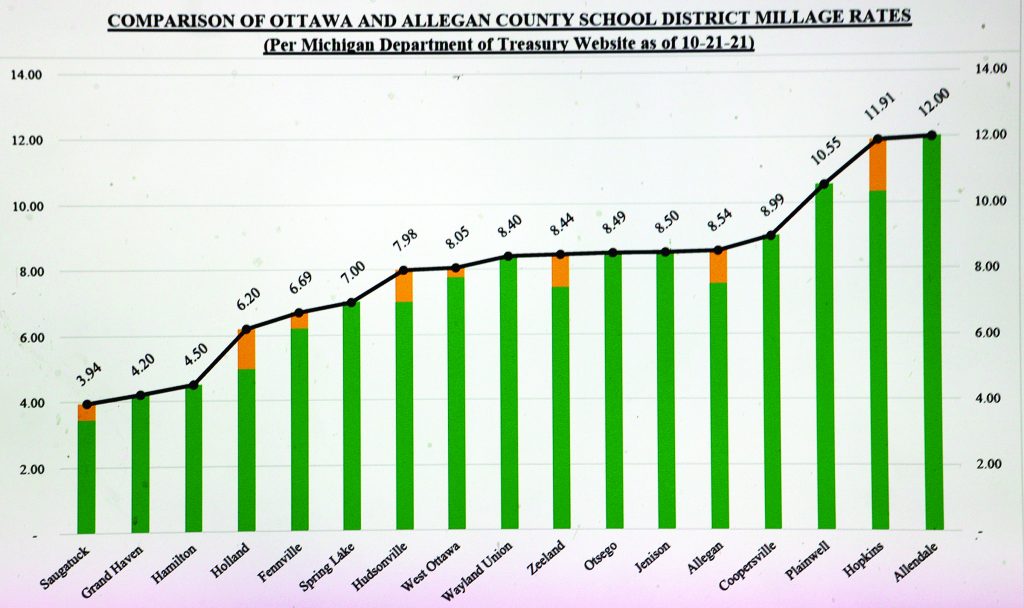
Saugatuck Public School District voters will be asked Nov. 8 whether to approve three separate millage requests. On the ballot will be:
• A 5-year operating millage proposal,
• A 5-year millage ask to fund operating a public recreation and playgrounds system, and
• A 3-year sinking fund millage proposal. These are not new taxes, as voters approved virtually identical operating millage and community recreation proposals in 2019, and a sinking fund proposal in 2018.
What is a non-homestead operating millage?
With the passage of Proposal A in 1994, Michigan schools are generally funded through a total of 24 mills levied on non-homestead property. This is a combination of a statewide millage rate of 6 mills on all property and 18 mills levied by school districts on non-homestead property when approved by local voters.
Under Proposal A, Michigan guarantees the district’s foundation allowance per pupil. In Saugatuck, the majority of operating funds come from the levy on non-homestead property. To receive full funding from the state, however, a school district must levy 18 mills on non-homestead property.
What does non-homestead mean?
Non-homestead represents industrial, commercial and some agricultural property and “second homes.” It does not include a family’s primary residence.
Why does the operating millage proposal have a “hold harmless” provision?
SPS has a 1.5 mills hold harmless millage included in the operating millage proposal. Under Proposal A, a qualifying district may levy a large enough homestead property tax millage to produce a total state and local revenue equal to the amount that was available to the district in 1995. The effect is to allow a hold-harmless district such as Saugatuck to continue to receive at least as much under Proposal A as it did before.
This ballot proposal, if approved, would help ensure that Saugatuck would be able to collect the full hold harmless amount locally during this five-year period. The district opted not to levy this hold harmless millage for the 2022-23 tax year.
How does the operating millage impact district school funding?
The combination of 18 mills on non-homestead property and the hold harmless mills would generate approximately $7,277,966 for the 2023-24 school year, approximately 65 percent of the district’s operating budget. If this proposal does not pass, the state would not replace the $7,277,966 of funding, which would limit the ability of the schools to operate. In that event, the district would need to cut the same amount of expenditures from its operating budget.
Why does the ballot language ask for an increase of 22 mills for the operating millage?
Under Proposal A, the district cannot levy more than 18 mills on non-homestead properties, even if it is voter approved. SPS is seeking an increase of 22 mills in its ballot language, with 4 additional mills included to guard against losing revenue due to a future Headlee Amendment rollback.
Even though only 18 mills can be levied at any time, by approving more than 18 mills, the district would likely be able to continue levying 18 mills for the foreseeable future in order to receive full funding from the state.
What is the millage proposal to provide funds to operate a system of public recreation and playgrounds?
If approved by voters, this will allow the district to continue to operate the community recreation program through 2027-28. The millage rate would remain the same at 0.25 mills as voters approved in 2019, raising approximately $202,596 in 2023-24. This equates to 100 percent of community recreation funding.
How are community rec funds used?
Since 2005, SPS Community Recreation has been funded by a 0.25-mill tax levy. Programs serve more than 2,500 community members annually through participation in more than 60 leagues, events and clubs.
More than 87 percent of Douglas Elementary students participate in community rec programs such as swim lessons, sports leagues, summer sports camps and ski club. Programs for adults include pickleball, tennis, self-defense, hiking club, yoga, fitness boot camp, volleyball and basketball.
What is the sinking fund proposal?
The 3-year ask for the building and site sinking fund supports ongoing technology purchases and upgrades, plus future repairs to school facilities not covered by the 2020 bond proposal. The millage rate would remain the same at 0.50 mills, as approved by voters in 2018. If OK’d, it would generate approximately $405,193 annually.
What can building and site sinking funds be used for?
They may provide for construction or repair of buildings, school security improvements, purchasing real estate for sites, plus acquiring and upgrading technology.
In the past, the district has used the building and site sinking fund to upgrade classroom technology and student Chromebooks, replace the boiler at Saugatuck Middle-High School, repair heating and cooling systems and roofing, for school security, and to resurface the track and tennis courts.
How does the district’s debt millage and sinking fund millage compare to other districts in Ottawa and Allegan counties?
The graph reproduced nearby shows SPS continues to have the lowest combined debt and sinking fund millage in Ottawa and Allegan counties.

